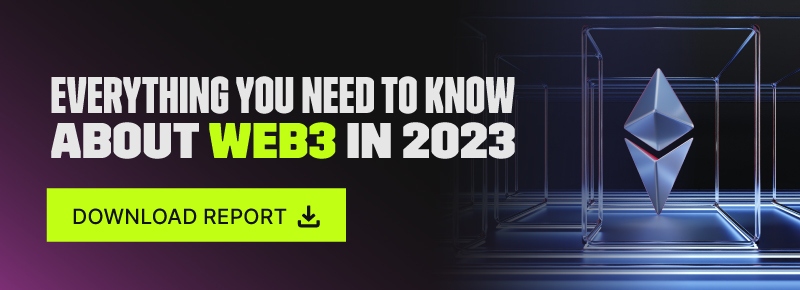What is Web3?: Unveiling the Next Frontier of the Internet
08 July 2023•
Do you ever feel a bit uneasy about the control that tech giants seem to have over your personal data and the online world? Then, say hello to Web3 – the groovy alternative, often dubbed “the future of the internet.”
The Basics of Web3
Web3 is all about decentralization, aiming to bring more democratization and transparency to the digital universe. Imagine a world without overbearing tech overlords or shady data collection practices. Sounds pretty good, right? The secret sauce is decentralized technologies like blockchain, which aims to systematically diffuse power from any single entity or authority. Instead, blockchain lets information be stored across a network of computers, eliminating the need for intermediaries and giving users greater control over their data and online interactions.
Picture Web3 as the great, new frontier in the internet landscape, where pioneers tap into their quest for freedom and autonomy, empowered by cutting-edge technology and some serious coding chops. Welcome to the next digital revolution!
Watch the Trailer Video: What's Hot in the World of Web3 in 2023
Web3 and its Origins
Web3 is an innovative concept representing the next evolutionary stage of the internet. Its foundations are deeply rooted in the early thoughts of Tim Berners-Lee, the founder of the World Wide Web. He first introduced the core concepts of decentralization, openness, and greater user utility in the 1990s:
|
Bottom-up design |
He advocated for code to be developed in full view of everyone, encouraging maximum participation and experimentation. (1) |
|
Decentralization |
Berners-Lee envisioned a web without a central authority, free from a single point of failure or control, and resistant to indiscriminate censorship and surveillance. (2) |
While Berners-Lee’s ideas laid the groundwork, the concept of Web3 truly emerged as a distinct idea separate from Web 3.0 (the semantic web). In 2006, journalist John Markoff coined the term “Web 3.0”, envisioning a future where machine learning and artificial intelligence would shape a more intelligent internet. However, it was Gavin Wood, the founder of Polkadot, who popularized the term “Web3” and helped to shape its vision for a more decentralized web, taking the concept to new heights.
Wood described Web3 as a decentralized internet where users control their own data and applications built on open, interoperable, and secure infrastructure. His company, Polkadot, is designed to connect different blockchains together into a single network, creating a decentralized web. The current definition of Web3 incorporates concepts of decentralization, blockchain technologies, and token-based economics while continuing to evolve.
In conclusion, understanding Web3’s origin requires recognizing its roots in Tim Berners-Lee’s early ideas and its divergence from Web 3.0. Web3’s evolution has centered around decentralization, openness, and user utility, emphasizing blockchain technologies and token-based economics. This unique approach sets it apart from Web 3.0 and paves the way for a more decentralized, user-centric digital world.
Infographic: Top Five Defining Features of Web3
There are a few unique features about the future of the internet that makes it distinctively different from the internet and the tech ecosystems that we currently operate in:
1. Decentralization:
Web3 is built on decentralized technologies such as blockchain, which enable the creation of decentralized applications, commonly referred to as dApps, that are not controlled by any single entity or authority.
2. Interoperability:
Web3 is designed to be more interoperable, meaning that different dApps and blockchain platforms can communicate and interact with each other seamlessly. Universal wallets such as Metamask (self-custodial wallet), cross-chain communication, interoperability layers, and standardization are just some of the tools being deployed in the Web3 ecosystem to ensure there won’t be any “Should I go with Apple Store vs. Google Play Store?” or “Playstation vs. Xbox?” questions in the Web3 space.
3. Token economics:
Many Web3 projects use token economics to incentivize users to contribute to the network and help govern its operations. This can help to create a more democratic and decentralized ecosystem by giving users a say in how the network is run.
4. Data Privacy & Security:
Web3 aims to increase data privacy and security by giving users greater control over their personal data and enabling them to share it securely with others on the network. This can help to prevent data breaches, identity theft, and other forms of cybercrime.
5. Open-source software:
Many Web3 projects use open-source software, which allows anyone to access and modify the code. This increases transparency and accountability by allowing users to see how the software works and verify that it is not engaging in malicious or unethical behaviour.
A History of the Web: Understanding the Evolution from Web 1.0 to Web3
Are you ready to take a trip down memory lane? We’re talking about the time when the only thing you could do on the web was play solitaire or chat with strangers in text-based chat rooms. Yep, we’re talking about Web 1.0, the era of dial-up and Tamagotchis. But hold on to your pagers because we’re now entering the era of Web3 and we have come a long way since those AOL days.
Infographic: The Evolution from Web1.0 to Web3
Web3 is already the fastest rate of adoption of any technology in human history
The adoption of blockchain, crypto, and Web3 is best represented by comparing the growth rate between the number of internet users and the number of identity-verified crypto asset users. Looking at the logarithmic scale, crypto adoption has seen the fastest adoption rate of any technology in human history and is well on its way to reaching one billion users in the next 2 to 4 years, depending on the adoption rate.
Infographic: Technology Adoption Curve - Log Scale
Web3 is already upon us
Don’t be fooled by its youth - Web3 is already shaking things up! Say goodbye to centralized apps and hello to decentralized ones. The future is bright, and it is already happening!
Infographic: The Old Centralized Apps vs. Decentralized Web3 Apps
Defining moments in Web3 history
Though the term “Web3” was popularized in 2014, almost a decade ago, by Dr. Gavin Wood, co-founder of Ethereum and creator of the Polkadot platform, to describe the vision of a decentralized internet enabled by blockchain technology, it is still in its infancy. Here is a brief historical timeline of key milestones in the development of Web3.
Infographic: The History of Web3, Crypto, and Blockchain: Top Key Moments
To read more about the future of web3, the decentralized web – read the full report here.
Next Read: The Dawn of Web3: Joseph Lubin’s Visionary Journey
References: (1) Berners-Lee, T. (1999) Weaving the Web: The Past, Present and Future of the World Wide Web, (2) Berners-Lee, T. (2000) Weaving the Web: The Original Design and Ultimate Destiny of the World Wide Web







%2Fuploads%2Fopportunities-web3%2Fcover.jpg&w=3840&q=75)